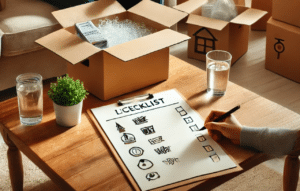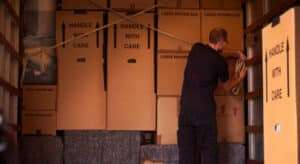How Inflation Has Affected Moving Costs in the United States
June 3, 2024
United States has experienced significant changes, and one area where the impact is felt profoundly is in the cost of moving. Whether you are planning an interstate move, looking for storage options, or simply trying to find the best deals on moving materials, the effects of inflation have created ripples that touch every aspect of the moving process. In this article, we will delve into the ways inflation has influenced moving costs and explore practical solutions for individuals and families navigating these challenges.
Inflation, the steady increase in general price levels, has become an integral part of the American economic story. The impact of inflation is far-reaching, affecting everything from groceries to housing, and of course, moving costs. As inflation rates soar, the expenses associated with moving, both locally and across state lines, have witnessed a notable uptick. This trend is particularly evident when considering interstate moving, where costs are influenced by fuel prices, labor expenses, and demand-supply dynamics.
Intestate moving, the process of relocating from one state to another, has become notably more expensive due to inflation. Fuel costs, a significant component of interstate moving expenses, have seen a sharp increase, directly affecting the overall cost of transporting goods over long distances. Additionally, labor costs have surged, reflecting the broader economic shifts in the job market. These factors, coupled with the rising costs of maintaining a moving vehicle fleet, have led to higher prices for interstate moving services.
One innovative solution that has gained popularity amidst rising storage moving costs is the utilization of moving pods. These portable storage units offer flexibility and convenience, allowing individuals to store their belongings securely without breaking the bank. Companies like PODS have revolutionized the storage and moving industry, offering cost-effective alternatives for those seeking storage solutions in an inflation-driven economy.
When facing escalating storage moving costs, it’s essential to explore budget-friendly options. Moving pods not only provide a more economical choice but also offer the convenience of on-demand storage. By opting for moving pods, individuals can store their belongings for a specific duration, mitigating the financial strain caused by inflation. Moreover, the accessibility and security offered by these units make them a practical choice for those in need of storage solutions during a move.
One often overlooked aspect of moving expenses is the cost of materials. From boxes to packing tape, these essentials can add up quickly, especially with inflation driving prices higher. To counter this, savvy movers are turning to cost-effective solutions such as buying moving boxes in bulk. Online marketplaces and specialty retailers offer competitive prices, allowing individuals to acquire the necessary materials without overspending. By planning ahead and sourcing moving materials strategically, movers can significantly reduce their overall expenses.
In the realm of moving, timing can make a substantial difference in costs. As inflation continues to impact the economy, choosing the right month for your move can result in significant savings. Historically, the moving industry experiences fluctuations in demand throughout the year. Understanding these patterns can empower individuals to make informed decisions. Moving during the off-peak season, often in the winter months, can yield substantial cost savings. By avoiding the peak summer season, characterized by high demand and consequently inflated prices, movers can stretch their budget further.
In conclusion, the effects of inflation on moving costs are undeniable. From interstate moving to storage solutions, every aspect of the moving process is influenced by the economic shifts in the country. However, armed with knowledge and strategic planning, individuals and families can navigate these challenges effectively.
Utilizing innovative storage solutions like moving pods, sourcing materials wisely, and choosing the optimal time for the move are practical strategies that can make a substantial difference. By adapting to the changing economic landscape and exploring budget-friendly alternatives, movers can ensure a smooth transition without breaking the bank.
Remember, staying informed, exploring innovative options, and planning ahead are the keys to managing moving costs in an inflationary environment. By making smart choices and leveraging available resources, individuals can successfully move to their new homes while keeping expenses in check.
For more insights into managing moving quotes, costs and navigating the complexities of relocation, visit WowMover. Explore their comprehensive guides and expert tips to make your move a seamless and affordable experience.
Perishable goods such as fresh produce, meat, dairy products, and prepared foods often do not travel well during an interstate move. The time spent in transit and inconsistencies in temperature and humidity levels can lead to spoilage.
Food items that require refrigeration are the most concerning, as it is difficult to ensure consistent cold temperatures throughout the moving process. Dairy, eggs, fresh meats and seafood, leftovers, etc. have potential to develop bacterial growth and become unsafe to eat if they warm above 40°F for an extended period.
Even hardy fruits and vegetables that do not require refrigeration can deteriorate quickly. Ethylene-producing fruits like apples, avocados, and tomatoes hasten ripening and rotting in other produce. Leafy greens wilt as they lose moisture. Processing produce by cutting or peeling accelerates spoilage as well.
For these reasons, it is best not to transport perishable foods during an interstate move. Either plan to consume these items before the move, donate them if possible, or be prepared to replace them at your new location. Non-perishable and shelf-stable items like canned goods, pasta, rice, oils, etc. can safely make the trip.
When moving across state lines, it’s important not to transport flammable or combustible liquids and gases. This includes items like:
Gasoline – Never transport gasoline in cans, portable tanks, or your vehicle’s main tank when moving. Not only is it dangerous, but it’s illegal in most states. Gasoline and its fumes can ignite easily and cause explosions.
Propane tanks – Full or partially-full propane tanks contain flammable gas under pressure and pose serious risks. Make sure propane tanks are completely empty before transporting them. Or better yet, don’t bring them at all and get new tanks at your destination.
Paint, stains, varnish – Oil-based paints and stains contain flammable solvents that can catch fire or combust. Only bring latex/water-based paints, and make sure the lids are tightly sealed.
Cleaning fluids, solvents – Household cleaners often contain alcohols, acetones, and other flammable liquids. Don’t load them into a moving truck or trailer.
The risks of transporting anything flammable or combustible far outweigh the benefits. It’s much safer to discard old paint cans, propane tanks, gasoline, etc. and buy new ones as needed at your new home. This also reduces the amount of hazardous waste you have to deal with during an interstate move.
Transporting firearms and ammunition across state lines can be tricky due to strict regulations. The general rule is that firearms must be unloaded and secured in a locked hard-sided container. Ammunition must also be properly packaged in boxes made specifically for that purpose.
The key things to know when moving firearms:
Individuals need to check the laws in every state they will be traveling through, as regulations vary widely. Some states prohibit certain types of firearms altogether.
Travelers should have a valid permit to carry if required by states along your route. Some states honor permits from others, while some do not.
Firearms should be declared when crossing state lines by stopping at weigh stations or checking with authorities.
Travelers cannot transport loaded firearms in their vehicle. Firearms must be unloaded and secured before starting your trip.
Ammunition must be kept in sealed boxes and stored away from firearms during transport. Do not store ammo loosely in bags or containers.
Violating state firearms laws during a move can result in weapons being confiscated and criminal charges filed. It’s essential to do thorough research ahead of time and take all necessary precautions. With prudent planning and care, firearms can be transported safely when relocating.
Moving plants across state lines can be tricky. Many houseplants and outdoor plants that thrive in one climate may not do well when transported to a new environment. The stress of an interstate move may shock plants and cause damage or death.
Fragile plants should generally be left behind or gifted rather than transported. Succulents, cacti and hardy houseplants have the best chance of surviving a long move. Make sure to inspect all plants closely for signs of disease or pests before packing, as transporting diseased plants may be prohibited.
When moving delicate plants, try to keep their environment stable. Water plants well before packing and transport in breathable boxes or containers. Keep plants away from extreme temperatures, out of direct sunlight, and pack with care to avoid damaging stems and leaves. Upon arrival, repot in fresh soil and allow time to recover in a gradual transition to their new climate. With extra preparation and care, some plants can make the move successfully. But a cross country trek is risky for many varieties.
When moving long distances, it’s best to transport jewelry, collectibles, heirlooms, and other valuables separately from the rest of your belongings. These items are at high risk of theft or loss during an interstate move.
Movers often recommend keeping irreplaceable items with you rather than trusting them to the moving truck. This reduces anxiety about their safety and security. You’ll have peace of mind knowing exactly where your most prized possessions are at all times.
Consider transporting jewelry yourself in a secure bag or case. This also allows you to properly insure them during the move. Many standard moving company insurance policies have low coverage limits for theft. But you can get extra coverage for valuables as a rider on your homeowners or renters policy.
Another option is using a shipping company that specializes in transporting valuables. They offer more security, insurance, tracking, climate control, and white glove service. This usually comes at a higher cost than self-transport, but reduces risk.
The bottom line is that you should avoid putting your most valuable or irreplaceable items on a truck full of furniture and boxes. Take extra precautions so you won’t suffer a huge loss if anything happens during an interstate relocation.
Best Moving companies typically will not transport prohibited or illegal items across state lines. This is for legal liability reasons as well as general safety. Some examples of prohibited items include:
Recreational drugs like marijuana, even in states where it is legalized. Transporting cannabis across state lines remains a federal offense. Movers will not risk transporting it.
Hazardous materials classified as hazardous waste. This includes chemicals, batteries, paints, pesticides, and other toxic substances that require special handling under Environmental Protection Agency regulations. Most moving companies are not licensed to transport hazardous waste.
Weapons like grenades, bombs, and rocket launchers. Even if you have the proper licensing, moving companies will not transport explosives or other extremely dangerous weapons.
Certain animal products like ivory, pelts, skins, feathers, etc may be prohibited if they violate laws like the Endangered Species Act or the Migratory Bird Treaty Act. Always check regulations.
Counterfeit or bootleg merchandise violates copyright and trademark laws. Pirated media, knockoff luxury goods, and illegal merchandise should never be transported by movers.
Other illegal contraband like stolen property or smuggled goods. Moving companies are obligated to reject loads containing clearly illegal items.
When in doubt, it’s best to consult with your mover about any questionable items. Attempting to transport prohibited items could void your contract and prevent you from filing claims for losses or damages. It’s not worth the risks.
Moving heavy exercise equipment like treadmills, weight benches, and stair steppers can be very difficult and is not recommended for an interstate move. These large fitness machines are cumbersome to move, require proper disassembly and packaging, and are prone to damage during loading, transit, and unloading.
The best option is to sell your exercise equipment and buy new equipment once you get settled in your new home. Trying to move treadmills, elliptical machines, rowing machines and other large fitness gear cross-country introduces unnecessary risk. These machines have sensitive components and complex mechanisms that can break easily if handled roughly.
Professional movers may refuse to move certain exercise equipment since it can exceed weight limits and dimensions for their truck or moving containers. Or movers may charge you exorbitant fees and extra costs to move exercise equipment. Either way, moving heavy bulky exercise gear long distances is impractical.
You’re better off selling your used exercise equipment and using the cash to purchase brand new machines once you get to your new destination. This avoids the costs and headaches associated with moving fitness gear, which often outweighs the value of the used equipment. Don’t risk your belongings getting damaged and incurring unexpected moving expenses. Leave the treadmills and weight benches behind.
Most cleaning supplies should be avoided when moving long distances. Products like bleach, ammonia, drain cleaner, oven cleaner, and other caustic chemicals pose a serious risk if they leak or spill during the moving process.
Some cleaning agents give off dangerous fumes that can be harmful to movers, or make other items in the truck smell unpleasant. A leaking bottle of bleach could also ruin clothing, upholstery, or carpeting. The shifting and bumpy nature of a long distance move makes spills and leaks much more likely.
It’s best to use up supplies of dangerous cleaning products before the move. If some remain, properly seal or dispose of them. For any you must transport, make sure lids are tight and bottles secured upright in a plastic tub or tote during loading. Declare them to the movers so they can take extra precautions.
Consider restocking cleaning supplies once you arrive at your new home. This eliminates the risk of spills, and allows you to buy products preferred for cleaning your new home. It also prevents chemicals from sitting in storage if move-in is delayed. Leave the dangerous cleaning products behind and start fresh with safer supplies after your move.
Certain licenses, permits, and government documents may not transfer between states. For example, driver’s licenses must be obtained in your new state of residence. Vehicle registrations and license plates also need to be updated when moving between states.
Other state-specific permits and licenses that require re-application in a new state include:
– Fishing and hunting licenses
– Concealed carry weapon permits
– Professional licenses (teaching credentials, trade certifications, etc.)
– Business licenses and tax IDs
– Marriage licenses
– Vehicle inspections
– Building permits
The process for transferring these documents or applying for new ones will depend on the specific regulations in your origin and destination states. Be sure to research well in advance what will be required to avoid any compliance issues or lapses in legal permissions when moving. Maintaining valid credentials is crucial, so budget extra time and expenses to transfer permits and licenses.
Normally rental equipment like heavy machinery and moving vehicles should stay within their local service area. Rental agreements prohibit transporting certain equipment like cranes, lifts, backhoes, generators, scissor lifts, and boom lifts out of the area without permission. This is to limit liability for the rental company.
Rented moving trucks also have mileage limits on how far they can go before incurring overage fees. Going out of state or across the country will lead to steep mileage fees. The rental company may even put a hold on your credit card for the value of the truck if they think you are violating the terms.
It’s best not to attempt moving rented equipment yourself. Return local rentals before your interstate move and find a national rental company that allows one-way moves. This avoids unauthorized moves and unexpected fees.
Relocating your household during interstate moves can be a daunting task, but what if you have a collection of precious musical instruments that require extra care? In this comprehensive guide, we will delve into the art of safeguarding musical instruments during interstate moves. From planning and packing to selecting the right moving services, we’ve got you covered.
Before you embark on your interstate journey, it’s crucial to plan meticulously. When musical instruments are part of your household, the planning process becomes even more vital. Here are some key considerations:
Proper packing is the key to ensuring the safety of your musical instruments during an interstate move. Here are some best practices:
Choosing the right moving services is a critical decision when you have valuable musical instruments. Here are some services to consider:
Hiring a professional moving company with experience in transporting musical instruments can provide peace of mind. These experts know how to handle instruments with care and ensure their safe arrival.
Did You Know? Many moving companies offer specialized services for musical instruments, including climate-controlled transportation and white-glove handling.
For temperature-sensitive instruments like violins or woodwinds, it’s essential to opt for climate-controlled transportation. This ensures that your instruments are protected from extreme temperatures.
Pro Tip: Check if the moving company has experience in transporting climate-sensitive instruments and inquire about their climate-controlled options.
While planning your interstate move, it’s crucial to assess your insurance coverage. Most standard moving insurance covers basic protection, but musical instruments may require additional coverage due to their value and fragility.
If you prefer a more hands-on approach, you can consider a DIY move. In this case, you’ll need to rent a suitable vehicle and equipment for the move. Ensure that you secure the instruments properly and protect them from potential damage.
When the moving day arrives, it’s natural to have some concerns about the well-being of your musical instruments. Here’s what you can expect during the move:
The cost of safeguarding your musical instruments during an interstate move can vary depending on several factors:
Find out how much your interstate move will cost by referring to our comprehensive guide on interstate moving costs.
For more information on planning and executing a successful interstate move, visit our homepage. Here, you’ll find a wealth of resources and tips to make your relocation as smooth as possible. Whether you’re looking for the best moving containers or want to understand average interstate moving costs, we’ve got you covered. Plus, if you’re considering storage options, don’t miss our recommendations for the best interstate moving and storage services. And if you’re unsure about the differences between interstate and intrastate moves, our guide on understanding interstate and intrastate moves can provide clarity.
Moving your musical instruments across state lines doesn’t have to be a daunting task. With careful planning, proper packing, and the right moving services, you can safeguard your precious musical treasures during an interstate move. Remember to assess your specific needs, choose the best protection options, and ensure that your instruments receive the care they deserve.
Moving to a new home, especially when it involves interstate moving, can be an exciting yet overwhelming experience for the entire family. Amidst the chaos of packing boxes and organizing logistics, parents often find themselves worrying about how their kids will cope with the transition. As a seasoned moving expert, I understand the challenges families face when moving with kids . In this comprehensive guide, we’ll explore practical strategies to help you prepare your kids for a move while keeping the process smooth and stress-free.
Moving can stir up a whirlwind of emotions in kids. They might feel excited about the new adventure but also anxious about leaving their familiar surroundings. It’s crucial to acknowledge and validate their feelings. Encourage them to express their concerns openly, creating a safe space for them to share their thoughts.
One way to ease children’s anxiety about moving is by involving them in the process. Let them help with packing their belongings, allowing them to make decisions about what to keep and what to donate or recycle. This involvement empowers them and gives them a sense of control over the situation.
Proper planning is the key to a successful move. Create a moving checklist outlining tasks to be completed before the moving day. This can include notifying schools, transferring medical records, and organizing important documents. By staying organized, you can reduce the last-minute rush and ensure a seamless transition for your kids.
When you arrive at your new home, make an effort to recreate a familiar environment for your kids. Arrange their room with their favorite furniture, toys, and bedding. Familiarity can provide a sense of security, helping them adjust to the new surroundings more easily.
Before the move, research the new neighborhood and its amenities. After the move, take the time to explore the area with your kids. Visit local parks, libraries, and community centers. Introducing them to their new surroundings will make them feel more comfortable and excited about their new home.
Kids thrive on routines, which provide stability and predictability. Amidst the chaos of moving, try to maintain essential routines like meal times and bedtime rituals. Consistency can help kids feel secure in the midst of change.
Encourage your kids to make new friends in the neighborhood or at their new school. Organize playdates, enroll them in local clubs or sports teams, and participate in community events. Building new friendships can help them feel connected and reduce feelings of isolation.
Adjusting to a new home takes time, and each kids copes differently. Be patient and supportive as they navigate their emotions. Offer reassurance, listen actively, and provide comfort when needed. Your understanding and support are crucial in helping them adapt to the changes.
Moving with kids can be challenging, but with thoughtful planning and emotional support, you can make the process smoother for the entire family. By acknowledging their feelings, involving them in the process, maintaining routines, and encouraging socialization, you can help your kids embrace the adventure of moving to a new home.
Remember, every kid is unique, so tailor your approach based on their individual needs and preferences. By following these strategies and staying attuned to your children’s emotions, you’ll pave the way for a positive and successful move, ensuring your family settles into your new home with ease.
For more expert advice and reliable moving services, visit WowMover. Our team of professionals is dedicated to making your move a stress-free and enjoyable experience. Happy moving!
The first step when preparing to transport fragile items is to take inventory and inspect all of them. Go through your home room-by-room and make a list of any items that could be damaged during the move, including things like:
– Glassware, dishes and ceramics
– Electronics like TVs, computers and tablets
– Antiques, collectibles and artwork
– Furniture with glass or delicate materials
– Musical instruments
– Memorabilia and photos
Carefully inspect each fragile item before packing it. Check for any existing cracks, chips or damage. Make notes about any flaws so you can determine later if any damage occurred during the move.
It’s also important to assess the value of each fragile item, both monetary and sentimental. The monetary value will determine how much insurance you need, while the sentimental value will guide how carefully you need to pack and transport the item. Replacing broken items with sentimental value is difficult. Note down what each fragile item is worth to potentially file insurance claims later if anything gets damaged.
Knowing the condition and value of your fragile possessions will help you determine which require special packing and extra care when loading, transporting and unloading during your move. Taking the time upfront to thoroughly assess fragile items helps prevent heartbreak over damaged treasured belongings.
When moving fragile possessions long distances, having the right boxes and packing materials is crucial. Here are some tips on selecting proper supplies:
New boxes are ideal for fragile items, as they haven’t been compromised by previous moves. Sturdy new boxes are less likely to tear or collapse under the weight of fragile contents. However, new boxes do come at a cost.
Used boxes from grocery or retail stores can work for less fragile items. Check that used boxes aren’t crushed, ripped, or water damaged. Avoid used boxes for irreplaceable items. Tape up any seams or edges to reinforce.
A good option is to use new boxes for fragile items like china or electronics, while repurposing sturdy used boxes for things like kitchenware, decor, or books.
Dish pack boxes with dividers are great for securing dishes, glasses, ceramics, etc. The dividers prevent breakage.
Mirror/picture boxes safely hold framed photos, paintings, and mirrors during transit.
For fragile sculptures, vases, lamps, etc use heavy duty cardboard boxes or wooden crates to prevent shifting and damage.
Wardrobe boxes with a metal bar are perfect for transporting hanging clothes.
You’ll need packing materials like:
Bubble wrap: Helps cushion delicate items like electronics or antiques. Pop the bubbles before wrapping for a tighter fit.
Newsprint or packing paper: Wraps and separates dishes, glasses, and fragile decor.
Foam peanuts: Fills empty spaces and absorbs shocks. For electronics, use anti-static foam peanuts.
Furniture pads: Protects furniture corners and edges from scratches.
Stretch wrap: Secures boxes to pallets.
Having quality boxes and packing materials tailored to your fragile possessions will give you peace of mind on moving day!
When packing fragile items for a move, it is crucial to wrap and pad them properly to prevent breakage. Here are some tips:
Wrap each item individually in bubble wrap or packing paper. Make sure to wrap all sides and corners. Use plenty of cushioning material.
For extra protection, wrap items in a layer of small bubble wrap first, then a layer of large bubble wrap. The bubbles provide shock absorption.
Pad bottom and sides of boxes with crumpled packing paper, foam peanuts, or inflatable packing pillows. This protects against any hard impacts during loading/unloading.
Place padded fragile items in the center of the box, surrounded on all sides by packing material. Do not pack too tightly.
Fill extra space in boxes with loosely crumpled packing paper or other lightweight padding. Do not overload boxes as this can crush fragile contents.
Secure items inside boxes with packing tape so they do not shift during transit. Tape down any loose padding material as well.
Label boxes clearly as “Fragile” so movers are extra careful when handling them.
Proper wrapping and securing of fragile goods will help ensure your valuables survive the journey intact. Take the time to carefully pack and pad delicate items using quality packing materials.
Clear labeling of your fragile boxes is crucial to ensure they are handled properly during the moving process. Here are some tips for effective labeling:
Use pre-printed “Fragile” stickers or make your own bold “Fragile” labels on each side of the box. This alerts movers to use extra caution.
Write the contents of the box in big, bold lettering – for example “Dishes” or “Lamps“. This helps movers understand what’s inside without opening.
Indicate which room each box should go in at your new home. Write something like “Master Bedroom” or “Kitchen” on the top and sides.
Number your boxes and keep a list indicating which numbered box goes in which room. This keeps boxes sorted if the room labels rub off.
Use a thick permanent marker so labels are clearly visible and don’t smear off if boxes get damp.
If using tape to affix labels, use packing tape or reinforced tape so they don’t peel off during transit.
Effective labeling takes a little extra time upfront, but it can prevent your fragile items from getting lost, broken, or placed in the wrong rooms during unloading. Take the time to clearly label each fragile box so movers can easily identify where it should go and handle it with care.
When loading your moving truck, be very strategic about where you place your fragile items to minimize movement and potential damage during transit. The optimal placement is on top of other items or near the cab of the truck.
Create layers in your truck using larger furniture items and pads or blankets to cushion the fragile boxes. Load heavy furniture like couches, tables, dressers first and use them to build a base layer. Then carefully load smaller fragile items on top using moving pads, blankets or bubble wrap to cushion them if needed.
Place fragile boxes labeled “FRAGILE” near the front of the truck, closest to the cab. This area will experience less bumps, vibrations and shifts while driving. Also avoid stacking fragile boxes or placing them underneath heavier objects.
Take your time and pack the truck methodically, starting with heavy furniture on the bottom, then fragile items layered on top strategically. Avoid overstuffing the truck too full as empty space helps limit movement. Also securely tie down all furniture and boxes to minimize shifting during transit. With some advance planning and care taken during loading, you can safely transport even the most delicate of possessions.
When transporting fragile items in a moving truck, it’s critical to drive as smoothly and safely as possible. Obey all speed limits, especially when going around turns or curves. If the posted speed limit on a turn seems too fast for your truck’s load, reduce your speed. Sudden acceleration or braking can shift the load and cause items to fall and break. Instead, accelerate gently from stops and brake early when you need to slow down. Try to avoid sudden stops completely. If you can anticipate when a light will change, start braking early rather than slamming on the brakes at the last second. By driving conservatively and defensively, you can significantly reduce the risk of fragile items shifting, falling over or colliding into each other during the drive. The most fragile boxes should be loaded last and nearest the cab, but maintaining a smooth, safe speed and avoiding sudden stops will help keep all boxes secure.
Keeping your boxes covered and dry during an interstate move is crucial for protecting fragile items. Moisture can damage many items, and soggy boxes are more likely to rip and spill their contents. Make sure to use a covered truck or trailer when possible, and consider renting a container that fully encloses your belongings. If hauling an open trailer, wrap a waterproof tarp snugly over the load.
Check the forecast before traveling and be prepared for rain or snow. Have spare tarps or plastic sheeting on hand to quickly cover your possessions if needed. Avoid driving through severe storms whenever you can. If caught in wet weather, pull over and wait it out if possible before continuing.
Extreme heat or cold can also be problematic. Boxes exposed to hot sun and high temperatures inside an enclosed truck could warp or melt some items. Try to park in the shade when stopping, and run the air conditioning to moderate the interior temperature if transporting boxes in hot weather. During cold months, prevent boxes from freezing by ensuring your truck cab is properly heated. Consider placing blankets over the load for extra insulation if concerned about freezing.
With smart preparation and care, you can deliver all your fragile belongings intact despite the challenges of long-distance moving. Taking steps to keep boxes dry, moderate temperature swings, and minimize weather exposure will protect your irreplaceable items.
When you reach your destination, be sure to have helpers available to assist with unloading the truck. Move fragile and delicate items first before heavier boxes. Carefully unload the boxes containing fragile items and set them down gently rather than dropping them or tossing them. Don’t try to speed through unloading. Take your time and handle fragile boxes with care.
If using a moving dolly, gently roll the dolly down the ramps, avoiding any bumps or jolts. When lifting boxes, bend at the knees and keep your back straight. Carry one box at a time and watch your footing as you bring items into the new home or apartment. Have a clear path prepared beforehand so you don’t have to maneuver around obstacles.
Place fragile boxes directly where you want that item to go, rather than moving it multiple times. Do a sweep of the new living space and make sure there are no tripping hazards. Keep kids and pets out of the way during the unloading process. Stay focused and patient. Proper handling while unloading will help ensure your fragile belongings arrive safely.
Once you arrive at your new home, make unpacking your fragile possessions a top priority. Don’t leave them sitting in the moving truck or in boxes any longer than necessary. Carefully unpack each fragile item and thoroughly inspect it for any new damage that may have occurred during the move.
Take your time and don’t rush the unpacking process. Handle each item gently as you remove it from its box and protective wrapping.
Closely examine the item from all angles, looking for any new chips, cracks, dents, or scratches. Pay particular attention to vulnerable areas like corners and edges.
If you spot any concerning damage, set the item aside for closer examination later. Take photos of the damage right away as documentation.
After unpacking all your fragile items, go back and inspect any that you had concerns about. Determine if the damage is cosmetic only or makes the item unsafe to use.
For valuable antiques, art, or collectibles, consider having a professional appraiser assess any damage. They can provide documentation if you need to file an insurance claim.
Document all new damage you discover through written notes, photographs, and video. This creates a record of when and how the damage occurred.
Carefully unpacking and inspecting your fragile belongings is a crucial final step to complete the safe transport of your items. It allows you to identify any moving-related damage as soon as possible and take appropriate action if needed. Don’t cut corners on this important process.
If any of your fragile items were damaged during the move, you may need to file an insurance claim. Here are some tips:
Document any new damage with photos. Take clear, detailed photos showing the extent of the damage. Photos provide important proof when filing your claim.
Know timeframes for insurance claims. Check the terms of your moving insurance policy so you know how soon you need to report damages. Many policies require you to submit claims within 60 days.
Be detailed when describing damages. Provide an accurate written description of each damaged item. Include specifics like size, brand, model number, color, etc. The more details you provide, the faster your claim can be processed.
Keep all original packaging materials. Do not throw away any original boxes or packing materials until your claim is finalized. Insurers may request them as part of the claims process.
Get repair estimates. For expensive or rare items, get written estimates from qualified repair specialists documenting the projected cost of repairs. Submit these with your claim.
Follow up on your claim. After submitting your claim, follow up periodically on the status. Ask what else you need to provide to expedite processing. Be persistent and keep detailed records.
Successful Interstate Moving Guide: Moving is most likely on everybody’s least favorite activity list. Regardless of whether it’s two or three houses down the road, a couple of states over, or cross-country, it is terrible without a doubt. It is exorbitant, tedious, and can be overpowering. To make it the least excruciating experience that could reasonably be expected and fruitful.
As soon as you know you are moving, have a plan. Whether you like to use a complicated spreadsheet on the computer or old-school pen and paper. You should write down everything that needs to get accomplished with a timeline.
Be up to date with school enrollment and utility installations. Nobody wants to walk into a new house with no power.
Also, Read: A Guide to Getting a Full Bond Refund: Two Men and a Truck
You want the only best movers to move your valuables but at a good price. Make sure to get at least three different quotes from different moving companies.
After you go through the different quotes, make a decision based on their reputation and it doesn’t hurt to ask around or read reviews. Cheaper isn’t always better.
When you change addresses there is a lot of documents that need to be updated such as your license and car registration. Make a list of all documents that need an address update and do it ASAP. Not a tip that should be ignored.
we can’t forget that you are putting your valuables in the hands of others. Check out what the moving company’s insurance covers and, depending on how much valuable you have, you may want to buy a better plan.
Now the simple stuff is out of the way , packing. Regardless of how frequently you have packed, long-distance is entirely another story. These tips will assist you with setting aside time and cash and furthermore ensure everything shows up in your new home securely and flawlessly.

Even though you know that your property is yours, it’s a lot easier just to check off a list to make sure everything has arrived.
Some items you may think you can eye if it fits or not. To make sure take measurements of the rooms so you don’t move a king-size bed frame that doesn’t fit.
This will save you money. Get rid of clothes you haven’t worn in a year, appliances you don’t use, and books you’ve already read. If you don’t love it, use it, or need it, toss it. If you have enough items you could hold a garage sale but either way, you will still save money by not having that much more to pack and move.
When you unpack it will be a lot easier to know which area of the house the items go into. As your pack label each box by area or room and you can even put a number that corresponds with the number on your inventory list.
before the movers get there make sure to go over your inventory list to ensure everything is accounted for upon arrival at your new home.
Here at Wowmover, our expert staff will help you on your next interstate move in a sheltered and opportune way. We are long movers with long periods of involvement effectively executing many moves all through the United States for families and organizations. It’s not possible for anyone to beat our low costs and solid movers. Presently it’s our chance to help make your interstate movement a total achievement.






Moving away from family can be an emotional rollercoaster. The excitement of starting a new chapter mingles with the pangs of leaving loved ones behind. Amidst the whirlwind of emotions, practical considerations like finding the right moving companies and ensuring a smooth interstate moving experience become paramount [En medio del torbellino de emociones, consideraciones prácticas como encontrar las empresas de mudanzas adecuadas y garantizar una experiencia de mudanza interestatal fluida se vuelven primordiales.] . At WowMover, we understand the intricacies of such a transition. In this guide, we offer you four invaluable tips to navigate this journey with grace and confidence.
Selecting the right moving company can make all the difference in ensuring a stress-free relocation. When moving away from family, entrusting your cherished belongings to reliable hands is essential. At WowMover, we’ve curated a list of the best full-service moving companies to help you find the perfect match. These companies offer a range of services, from packing and loading to transportation and unloading, ensuring a seamless experience.
Pro Tip: “A trustworthy moving company not only handles your possessions with care but also provides peace of mind during this significant transition.” – WowMover Team
Moving away from family isn’t just about transporting your belongings; it’s about navigating the emotional terrain of goodbyes and new beginnings. Acknowledge your feelings and give yourself permission to experience them fully. Reach out to friends, join local communities, and explore social groups in your new location. Establishing connections can ease the transition and create a sense of belonging.
Quote: “Moving away from family can be emotionally challenging, but it’s also an opportunity for personal growth and new experiences. Embrace the journey, and you’ll find unexpected joys along the way.” – WowMover Team
When moving across states, the safety of your possessions is paramount. It’s crucial to understand the risks of hiring a cheap moving company. While cost-saving is essential, compromising on the reliability of your moving company can lead to unforeseen damages. Familiarize yourself with movers’ insurance policies, and consider additional insurance if your belongings hold significant sentimental or monetary value.
Pro Tip: “Investing in movers’ insurance provides an added layer of protection, ensuring that your possessions are safeguarded throughout the journey.” – WowMover Team
Embrace your move as an opportunity for a fresh start. Research your new neighborhood, schools, healthcare facilities, and local amenities. Having a good grasp of your new surroundings helps you settle in with confidence. Additionally, plan a visit to your new city before the move, if possible. Familiarize yourself with the area, explore potential neighborhoods, and make connections with local residents. Arriving prepared nurtures a positive outlook, making the adjustment period smoother.
Quote: “Moving away from family is a significant change, but it’s also an adventure filled with possibilities. Embrace the unknown, and you’ll discover the richness of your new environment.” – WowMover Team
Moving away from family can be both daunting and exhilarating. With the right mindset and the support of reliable partners, this transition can mark the beginning of a fulfilling new chapter. At WowMover, we’re not just movers; we’re your companions on this transformative journey. Embrace the challenges, cherish the memories, and step into your new life with enthusiasm. Your future awaits, and we’re here to help you navigate every step of the way.